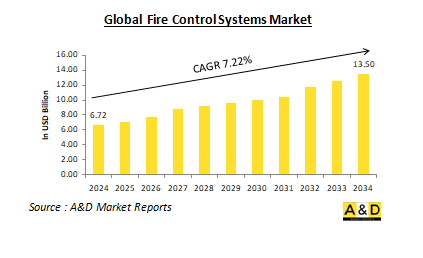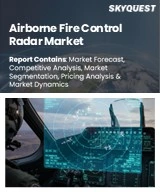
|
시장보고서
상품코드
1552534
세계의 사격 통제 시스템 시장(2024-2034년)Global Fire Control Systems Market 2024-2034 |
||||||
세계 사격 통제 시스템 시장은 2024년 67억 2,000만 달러로 추정되며, 2024년부터 2034년까지 연평균 7.22% 성장하여 2034년에는 135억 달러로 성장할 것으로 예상됩니다.

세계 사격 통제 시스템 시장 소개 :
사격 통제 시스템(FCS)은 현대 군사 플랫폼의 필수적인 구성 요소로, 무기 시스템의 정확성, 효과성 및 운영 효율성을 향상시키도록 설계되었습니다. 이 시스템은 센서, 컴퓨터, 무기를 조정하여 적대적 위협을 추적, 표적화, 교전할 수 있도록 합니다. 처음에는 대포와 해군 플랫폼용으로 개발된 사격 통제 시스템은 이후 탱크, 항공기, 미사일 방어 시스템 등으로 확장되어 현대전에 필수적인 요소로 자리 잡았으며, FCS는 전통적인 기동 작전에만 국한되지 않고 역동적인 전투 환경에서 정확한 조준을 위한 첨단 조준 및 조준을 위해 개발되었습니다. FCS는 레이더, 소나, 전기 광학 시스템에서 실시간 데이터를 통합하여 사격 솔루션을 계산하고, 사거리, 속도, 날씨 등의 변수를 자동으로 조정하여 무기를 목표물에 조준할 수 있는 첨단 센서 기술과 결합하여 사용되기도 합니다. 위협이 점점 더 고도화되는 복잡한 전쟁의 시대에 FCS는 교전의 정확성과 속도를 향상시켜 군에 전략적 우위를 제공합니다. 사격 통제 시스템 세계 시장은 기술 발전, 지정학적 긴장 고조, 군비 현대화에 대한 관심 증가에 힘입어 빠르게 성장하고 있습니다. 전투 정확도 향상의 필요성과 새로운 위협에 신속하게 대응할 수 있는 통합 방어 시스템에 대한 수요 증가는 육상 차량, 함정, 방공 시스템 등 다양한 플랫폼에서 이러한 시스템 개발을 촉진하는 주요 요인이 되고 있습니다.
세계 사격통제 시스템 시장에서 기술의 영향:
기술의 발전은 전 세계 사격 통제 시스템(FCS)을 크게 변화시키고 있으며, 기존의 역할을 넘어 그 능력을 확장하고 있습니다. 최신 FCS는 인공지능(AI), 머신러닝, 첨단 센서, 자동화 등 첨단 기술을 통합하여 군이 전장에서 작전을 수행하는 방식을 근본적으로 변화시키고 있으며, AI와 머신러닝은 대규모 데이터 세트를 처리하고 실시간으로 진화하는 전투 상황에 적응하여 목표물 인식과 추적을 강화하고 인간 오류를 최소화하면서 의사결정의 정확성을 향상시킵니다. 레이더, 적외선, 전기 광학 센서의 데이터를 결합하는 센서 융합을 통해 이러한 시스템은 전자전이나 악천후와 같은 악조건에서도 여러 표적을 동시에 탐지, 추적 및 교전할 수 있습니다.에 대한 인간의 개입을 줄이고, 자율 표적 설정 시스템이 신속하게 위협을 식별하고 교전할 수 있게 해줍니다. 또한, FCS가 네트워크화됨에 따라 사이버 공격에 대한 취약성이 증가함에 따라 군사 작전을 보호하기 위해 강력한 사이버 보안이 필수적이며, 장거리 정밀 타격, 특히 미사일 방어 및 포병에서 GPS 및 위성 데이터를 활용하여 수백 킬로미터 떨어진 표적을 공격하는 데 필수적인 역할을 하고 있습니다. 수백 킬로미터 떨어진 표적을 공격하는 데 필수적인 역할을 하고 있습니다. 마지막으로, FCS는 현재 네트워크 중심 전쟁의 틀 안에서 운영되고 있으며, 여러 군부대가 실시간 데이터를 공유하여 공격을 조정하고 부수적 피해를 줄이면서 전장의 효율성을 향상시킬 수 있게 해줍니다. 이러한 기술적 발전은 현대전에서 FCS의 효과와 정확성을 재정의하고 있습니다.
세계 사격 통제 시스템 시장의 주요 촉진요인:
현대 전쟁의 복잡성, 기술 혁신, 국방 예산 증가, 지정학적 역학 관계의 변화 등 여러 요인이 사격 통제 시스템(FCS)의 세계 성장과 채택을 촉진하고 있습니다. 현대 전쟁, 특히 전투원과 민간인이 섞여 있을 수 있는 비대칭 분쟁에서는 정밀한 표적 설정과 부수적 피해 최소화가 중요하며, FCS는 이러한 환경에서 매우 중요한 표적 교전을 보다 정확하게 수행할 수 있게 해줍니다. 지정학적 긴장과 지역 분쟁을 배경으로 한 국방 예산 증가도 각국이 군를 현대화하려는 노력의 일환으로 첨단 FCS 조달에 박차를 가하고 있습니다. 또한, 극초음속 미사일과 같은 무기 시스템의 발전은 고속으로 이동하는 표적을 추적하고 교전하기 위해 고도로 정교한 FCS를 필요로 합니다. 드론이나 무인 지상 차량과 같은 자율 시스템과 FCS의 통합도 중요한 원동력인데, 이러한 플랫폼은 사람의 개입 없이 작동하는 고도의 FCS에 의존하고 있기 때문입니다. 미사일 공격의 위협이 증가함에 따라 미사일 방어 시스템에 대한 투자도 증가하고 있으며, FCS는 날아오는 위협을 탐지하고 요격하는 데 필수적입니다. 마지막으로, 동유럽, 아시아태평양, 중동 등 지역의 지정학적 긴장은 각국이 전략적 우위를 유지하고 국가 및 비국가 주체의 잠재적 위협으로부터 보호하기 위해 첨단 FCS에 대한 투자를 촉진하고 있습니다.
세계 사격 통제 시스템 시장의 지역별 동향 :
사격 통제 시스템(FCS)의 채택과 개발은 지역마다 크게 다르며, 국방 우선순위, 기술력, 지정학적 역학관계에 영향을 받습니다. 북미에서는 미국이 방대한 군사 인프라와 현대화 노력, 특히 미사일 방어 및 해군용 AI 및 자율기술의 통합에 힘입어 세계 시장을 선도하고 있습니다. 캐나다도 해군 플랫폼을 위한 첨단 FCS에 투자하고 있습니다. 유럽에서는 NATO 회원국들이 군사 현대화 노력의 일환으로 FCS에 대한 투자를 늘리고 있으며, 독일, 영국, 프랑스 등은 NATO 내 미사일 방어와 상호운용성에 초점을 맞추었습니다. 우크라이나 사태로 인해 이 지역에서 첨단 FCS에 대한 수요가 증가하고 있습니다. 아시아태평양에서는 남중국해, 한반도, 인도-중국 국경의 긴장이 고조되면서 FCS 도입이 빠르게 진행되고 있습니다. 중국, 일본, 인도, 한국은 군사력을 강화하기 위해 FCS에 많은 투자를 하고 있으며, 중국은 군사적 야망을 지원하기 위해 독자적인 시스템을 개발하고 있습니다. 중동에서는 이스라엘, 사우디아라비아, 아랍에미리트 등이 주요 인프라를 보호하고 미사일 위협에 대응하기 위해 첨단 FCS를 도입해 이 지역을 선도하고 있습니다. 아프리카와 라틴아메리카에서는 예산 제약으로 인해 FCS 도입이 늦어지고 있지만, 국경 보안, 대테러 및 평화 유지에 대한 관심이 높아지고 있습니다. 이 지역의 국방 예산이 증가함에 따라 군사력을 현대화하기 위해 FCS에 투자하는 국가가 늘어날 것으로 예상됩니다.
세계 사격 통제 시스템 시장의 주요 프로그램
Leonardo DRS는 미 육군으로부터 박격포 사격통제 시스템, 관련 하드웨어 및 훈련 지원 서비스를 제공하는 5년 9,910만 달러 규모의 계약을 수주했습니다. 이 계약에는 무기 및 사격 통제 하드웨어 조달, 이러한 시스템의 창고 보관 및 배치 지원, 육군 프로젝트 관리자 전투 탄약 시스템이 감독하는 프로그램에 대한 엔지니어링 서비스가 포함됩니다.
이탈리아는 CAMM-ER 지대공 미사일 시스템의 능력을 업데이트하기 위해 OCCAR와 계약 수정에 서명했습니다. 이 기능 향상에는 지휘 통제 기능을 향상시키기 위한 새로운 사격 통제 유닛의 개발이 포함됩니다. 이탈리아의 방공 전략에서 중요한 역할을 하는 CAMM-ER은 다양한 공중 위협에 대한 종합적인 방어를 제공하도록 설계되었습니다.
독일 군수 조달 기관은 Hensoldt에 'Dynahawk' 사격 통제 조준기(FLV)를 독일군에 주문했습니다. 이 수백만 유로 규모의 계약에서 조준기의 정확한 수량은 공개되지 않았지만, 올해와 내년에 납품이 예정되어 있으며, 2026년까지 계약을 연장할 수 있는 옵션도 있습니다. '다이나호크'는 배치된 대전차 무기의 동적 및 원거리 표적에 대한 선제공격 정확도를 크게 향상시킬 것으로 기대되고 있습니다.
목차
사격 통제 시스템 시장 : 보고서 정의
사격 통제 시스템 시장 분석
- 지역별
- 플랫폼별
- 조작 방법별
사격 통제 시스템 시장 분석(향후 10년간)
사격 통제 시스템 시장 기술
세계의 사격 통제 시스템 시장 예측
사격 통제 시스템 시장 : 지역별 동향과 예측
- 북미
- 시장 성장 촉진요인 및 억제요인, 과제
- PEST 분석
- 시장 예측과 시나리오 분석
- 주요 기업
- 공급업체 Tier 상황
- 기업 벤치마킹
- 유럽
- 중동
- 아시아태평양
- 남미
사격 통제 시스템 시장 : 국가별 분석
- 미국
- 방위 계획
- 최신 동향
- 특허
- 현재의 시장 기술 성숙도
- 시장 예측과 시나리오 분석
- 캐나다
- 이탈리아
- 프랑스
- 독일
- 네덜란드
- 벨기에
- 스페인
- 스웨덴
- 그리스
- 호주
- 남아프리카공화국
- 인도
- 중국
- 러시아
- 한국
- 일본
- 말레이시아
- 싱가포르
- 브라질
사격 통제 시스템 시장 : 시장 기회 매트릭스
사격 통제 시스템 시장 : 조사에 관한 전문가의 견해
결론
Aviation and Defense Market Reports에 대해
LSH 24.09.23The Global Fire Control Systems Market is estimated at USD 6.72 billion in 2024, projected to grow to USD 13.50 billion by 2034 at a Compound Annual Growth Rate (CAGR) of 7.22% over the forecast period 2024-2034

Introduction to Global Fire Control Systems Market:
Fire control systems (FCS) are integral components of modern military platforms, designed to enhance the accuracy, effectiveness, and operational efficiency of weapon systems. These systems coordinate sensors, computers, and weaponry to track, target, and engage hostile threats. Initially developed for artillery and naval platforms, fire control systems have since expanded to include tanks, aircraft, and missile defense systems, making them essential in modern warfare. FCS are not just limited to traditional kinetic operations but are also used in conjunction with advanced sensor technologies to ensure precision targeting in dynamic combat environments. They integrate real-time data from radar, sonar, or electro-optical systems to compute firing solutions, automatically adjust for variables such as range, speed, and weather, and then direct weapons to their targets. In an era of complex warfare with increasingly sophisticated threats, FCS provide military forces with a strategic advantage by enhancing the accuracy and speed of engagements. The global market for fire control systems is growing rapidly, fueled by advancements in technology, rising geopolitical tensions, and an increasing focus on modernizing military forces. The need for enhanced precision in combat and the rising demand for integrated defense systems that can respond quickly to emerging threats are major factors driving the development of these systems across various platforms, including land-based vehicles, naval ships, and air defense systems.
Technology Impact in Global Fire Control Systems Market:
Technological advancements are significantly transforming global fire control systems (FCS), extending their capabilities beyond traditional roles. Modern FCS now integrate cutting-edge technologies such as artificial intelligence (AI), machine learning, advanced sensors, and automation, fundamentally changing how militaries conduct battlefield operations. AI and machine learning enhance target recognition and tracking by processing large datasets and adapting to evolving combat situations in real-time, improving decision-making accuracy while minimizing human error. Sensor fusion, which combines data from radar, infrared, and electro-optical sensors, allows these systems to detect, track, and engage multiple targets simultaneously, even under adverse conditions like electronic warfare or harsh weather. Automation in FCS has reduced human involvement in complex targeting processes, enabling autonomous targeting systems to identify and engage threats swiftly. Moreover, as FCS become more networked, they are increasingly vulnerable to cyberattacks, making robust cybersecurity essential for safeguarding military operations. FCS have also become crucial for long-range precision strikes, particularly in missile defense and artillery, utilizing GPS and satellite data to hit targets hundreds of kilometers away. Finally, FCS now operate within network-centric warfare frameworks, allowing multiple military units to share real-time data, coordinate attacks, and improve battlefield efficiency while reducing collateral damage. These technological advancements are redefining the effectiveness and precision of FCS in modern warfare.
Key Drivers in Global Fire Control Systems Market:
Several factors are driving the global growth and adoption of fire control systems (FCS), including the increasing complexity of modern warfare, technological innovations, rising defense budgets, and evolving geopolitical dynamics. Modern warfare now emphasizes precision targeting and minimizing collateral damage, especially in asymmetric conflicts where combatants may be intermingled with civilians. FCS enable forces to engage targets with greater accuracy, which is crucial in such environments. Rising defense budgets, spurred by geopolitical tensions and regional conflicts, are also fueling the procurement of advanced FCS as nations seek to modernize their militaries. Additionally, advancements in weapon systems, like hypersonic missiles, require highly sophisticated FCS to track and engage fast-moving targets. The integration of FCS with autonomous systems, such as drones and unmanned ground vehicles, is another key driver, as these platforms rely on advanced FCS to operate without human intervention. The growing threat of missile attacks has increased investment in missile defense systems, where FCS are essential for detecting and intercepting incoming threats. Finally, geopolitical tensions in regions such as Eastern Europe, the Asia-Pacific, and the Middle East are pushing nations to invest in advanced FCS to maintain a strategic advantage and protect against potential threats from both state and non-state actors.
Regional Trends in Global Fire Control Systems Market:
The adoption and development of fire control systems (FCS) vary significantly across regions, influenced by defense priorities, technological capabilities, and geopolitical dynamics. In North America, the United States leads the global market, driven by its vast military infrastructure and modernization efforts, particularly in integrating AI and autonomous technologies into missile defense and naval applications. Canada is also investing in advanced FCS for its naval platforms. In Europe, NATO members are increasing investments in FCS as part of military modernization efforts, with countries like Germany, the UK, and France focusing on missile defense and interoperability within NATO. The conflict in Ukraine has heightened the demand for advanced FCS in the region. The Asia-Pacific region is experiencing rapid growth in FCS adoption, fueled by rising tensions in the South China Sea, the Korean Peninsula, and the India-China border. China, Japan, India, and South Korea are heavily investing in FCS to strengthen military capabilities, with China developing indigenous systems to support its military ambitions. In the Middle East, countries like Israel, Saudi Arabia, and the UAE are leading the region in adopting advanced FCS to protect critical infrastructure and counter missile threats. In Africa and Latin America, the adoption of FCS is slower due to budget constraints, but interest is growing in using these systems for border security, counter-terrorism, and peacekeeping. As defense budgets rise in these regions, more countries are expected to invest in FCS to modernize their military capabilities.
Key Global Fire Control Systems Market Program:
Leonardo DRS has been awarded a potential five-year, $99.1 million contract by the U.S. Army to supply mortar fire control systems, along with associated hardware and training support services. The contract encompasses the procurement of weapons and fire control hardware, warehousing and deployment support for these systems, as well as engineering services for programs overseen by the Army's Project Manager Combat Ammunition Systems.
Italy has signed a contract amendment with OCCAR to upgrade the capabilities of its CAMM-ER surface-to-air missile systems. This enhancement includes the development of a new fire control unit aimed at improving command and control functions. The CAMM-ER, which plays a crucial role in Italy's air defense strategy, is designed to offer comprehensive protection against a range of airborne threats.
Germany's armament procurement agency has placed an order for "Dynahawk" fire control sights (FLV) from Hensoldt for the German Armed Forces. While the exact quantity of sights in this multi-million-euro contract has not been disclosed, deliveries are scheduled for this year and the next, with an option to extend the contract through 2026. The "Dynahawk" is expected to significantly enhance the first-hit accuracy on dynamic and distant targets for deployed anti-tank weapons.
Table of Contents
Fire Control Systems Market Report Definition
Fire Control Systems Market Segmentation
By Region
By Platform
By Operation
Fire Control Systems Market Analysis for next 10 Years
The 10-year Fire Control Systems Market analysis would give a detailed overview of Fire Control Systems Market growth, changing dynamics, technology adoption overviews and the overall market attractiveness is covered in this chapter.
Market Technologies of Fire Control Systems Market
This segment covers the top 10 technologies that is expected to impact this market and the possible implications these technologies would have on the overall market.
Global Fire Control Systems Market Forecast
The 10-year Fire Control Systems Market forecast of this market is covered in detailed across the segments which are mentioned above.
Regional Fire Control Systems Market Trends & Forecast
The regional Fire Control Systems Market trends, drivers, restraints and Challenges of this market, the Political, Economic, Social and Technology aspects are covered in this segment. The market forecast and scenario analysis across regions are also covered in detailed in this segment. The last part of the regional analysis includes profiling of the key companies, supplier landscape and company benchmarking. The current market size is estimated based on the normal scenario.
North America
Drivers, Restraints and Challenges
PEST
Market Forecast & Scenario Analysis
Key Companies
Supplier Tier Landscape
Company Benchmarking
Europe
Middle East
APAC
South America
Country Analysis of Fire Control Systems Market
This chapter deals with the key defense programs in this market, it also covers the latest news and patents which have been filed in this market. Country level 10 year market forecast and scenario analysis are also covered in this chapter.
US
Defense Programs
Latest News
Patents
Current levels of technology maturation in this market
Market Forecast & Scenario Analysis
Canada
Italy
France
Germany
Netherlands
Belgium
Spain
Sweden
Greece
Australia
South Africa
India
China
Russia
South Korea
Japan
Malaysia
Singapore
Brazil
Opportunity Matrix for Fire Control Systems Market
The opportunity matrix helps the readers understand the high opportunity segments in this market.
Expert Opinions on Fire Control Systems Market Report
Hear from our experts their opinion of the possible analysis for this market.
Conclusions
About Aviation and Defense Market Reports



















